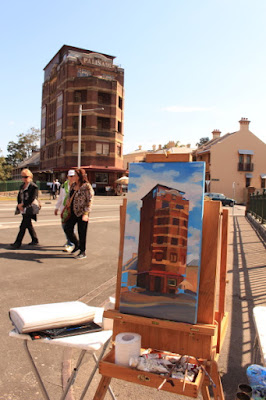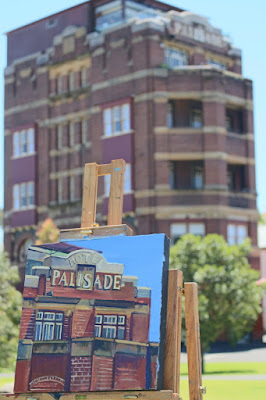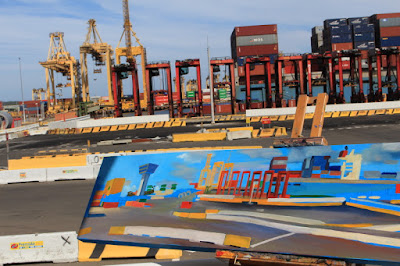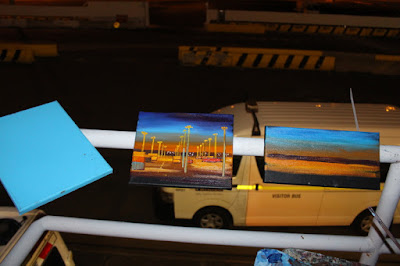 | |
|
 |
| MP11 'Merriman st' 2014 oil on canvas 46 x 61cm Available |
First the maritime workforce, then the surrounding community was dispersed.
 |
| MP11 'Merriman st' 2014 oil on canvas 46 x 61cm Available |

 | |
|
 |
| MP11 'Merriman st' 2014 oil on canvas 46 x 61cm Available |
 |
| MP11 'Merriman st' 2014 oil on canvas 46 x 61cm Available |
 |
| W33 'Walsh Bay Wharves from Wharf 8-9' 1999 oil on canvas 61 x 101cm |
 |
| W33 'Walsh Bay Wharves from Wharf 8-9' 1999 oil on canvas 61 x 101cm |



In 2014, when I painted this canvas, there was a small park in front of the Palisade. It was overgrown, but its figtrees were a welcome source of shade in summer. Since the redevelopment of this area, the park is now a wide green lawn with a few saplings which will need a lot of time before they provide shade.
MP7A Hotel Palisade 2014
oil on canvas 36 x 46cm
Available
There had been an earlier, much smaller hotel built on this site in the 1880s but it was pulled down in the frenzy of slum clearances at the beginning of the 20th century.
After the end of the bubonic plague crisis in the first decade of the 20th century, the population in Millers Point increased so much that the Sydney Harbour Trust had to build replacement hotels to cater to the port workers. Henry Deane Walsh was commissioned to build the new Palisade Hotel, one of 4 that were built by the Trust, the others being Dumbarton Castle, the 'Big House' (Moretons in Sussex Street- now the Sussex Hotel) and the Harbour View Hotel. 
MP30 The Reopening of the Palisade
2015 oil on canvas 51 x 25cm
Enquiries about similar paintings
The 5 storey hotel was built in 1915-16, and was one of the last Sydney buildings to be designed in the 'Federation Free' style, with parapets, and sandstone banding decorating the red brick masonry.
From the 1920s the head lease for the hotel was owned by Tooth and Co. who sub let it to various licensees.
MP30 The Reopening of the Palisade
2015 oil on canvas 51 x 25cm
Enquiries about similar paintings
From
1936, when the role of the Sydney Harbour Trust was taken over by the
newly formed Maritime Service Board, title to the hotel was issued to
the MSB, although Tooths continued to lease it until 1950. At that time
the licensee, P. K. Armstrong, obtained the lease.
In February 1987 title passed from the MSB into private ownership, then in 1994, Palisade Properties Pty Ltd obtained title.



 |
| MP39 'Sign of the Palisade' 2014 oil on canvas 31 x 31cm Available for sale |

 | |
| Painting a panorama of Port Botany 31 x 153cm oil on canvas 2015 Enquiries |
 |
| Painting a panorama of Port Botany 31 x 153cm oil on canvas 2015 Enquiries |
 |
| Painting a panorama of Port Botany 31 x 153cm oil on canvas 2015 Enquiries |
 |
| Painting a panorama of Port Botany 31 x 153cm oil on canvas 2015 Enquiries |
 |
| Painting a panorama of Port Botany 31 x 153cm oil on canvas 2015 Enquiries |
 |
| Painting the giant straddle cranes Port Botany 75 x 100cm oil on canvas 2015 Enquiries |
 |
| Painting the giant straddle cranes Port Botany 75 x 100cm oil on canvas 2015 Enquiries |
 |
| Paintings of Port Botany Left to right: the giant straddle cranes Port Botany 75 x 100cm oil on canvas 2015 giant straddle cranes Port Botany 100 x 75cm oil on canvas 2015 Night panorama straddle cranes Port Botany 31 x 153cm oil on canvas 2015 Port Botany panorama 31 x 153cm oil on canvas 2015 Enquiries I know that it's all in the name of efficiency, but when I left, it looked like a ghost town. |
 |
| Night,containers, Port Botany 25 x 31cm oil on canvas 2015 Night, Port Botany panorama 20 x 40cm oil on canvas 2015 Enquiries As
the last ship before the changeover was unloaded, a line formed of the
old straddle cranes which were due to be scrapped soon after. |


 |
MP9 'Millers Point, Barangaroo and the Harbour Tower from High st' oil on canvas 61 x 183cm 2014 Enquiries |
 |
| MP9 'Millers Point, Barangaroo and the Harbour Tower from High st' oil on canvas 61 x 183cm 2014 Enquiries |
 |
| MP9 'Millers Point, Barangaroo and the Harbour Tower from High st' oil on canvas 61 x 183cm 2014 Enquiries |
 |
| The artist painting MP9 'Millers Point, Barangaroo and the Harbour Tower from High st' oil on canvas 61 x 183cm 2014 Enquiries |
%2Bcrop.jpg) |
| Painting MP9 'Millers Point. Barangaroo and the Harbour Tower from High st' oil on canvas 61 x 183cm 2014 Enquiries |
 |
| Painting MP9 'Millers Point, Barangaroo and the Harbour Tower from High st' oil on canvas 61 x 183cm 2014 Enquiries |
 |
| Sunset, Millers Point. MP9 'Millers Point Barangaroo and the Harbour Tower from High st' oil on canvas 61 x 183cm 2014 with another half finished panorama of the same size of High Street and Barangaroo on my easel. Enquiries |
 |
| Close up detail of gate with yellow ribbon on house in High Street MP9 'Millers Point Barangaroo and the Harbour Tower from High st' oil on canvas 61 x 183cm 2014 Enquiries |
 |
| Painting MP9 'Millers Point, Barangaroo and the Harbour Tower from High st' oil on canvas 61 x 183cm 2014 Enquiries |
 |
Close up detail showing the partly obscured "Barangaroo" sign MP9 'Millers Point Barangaroo and the Harbour Tower from High st'
oil on canvas 61 x 183cm 2014 |